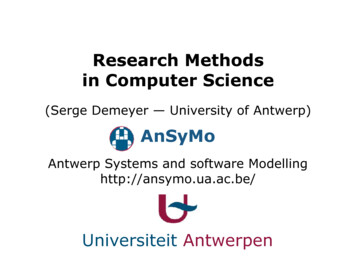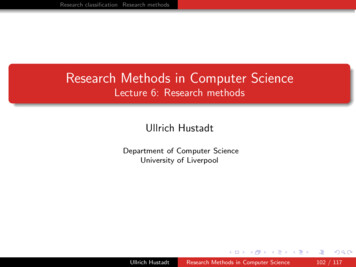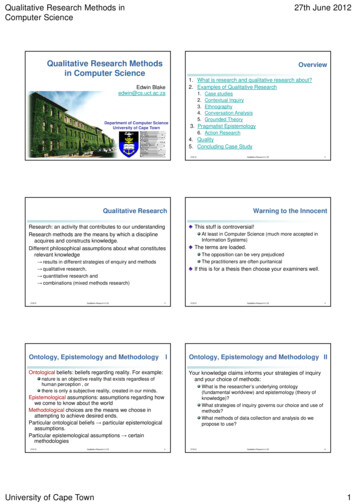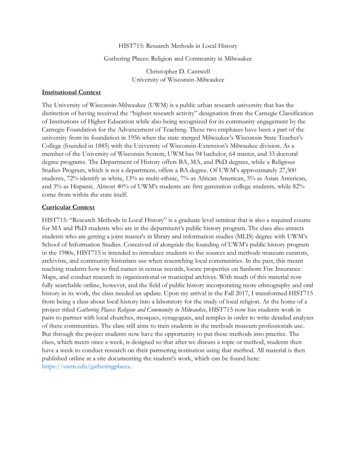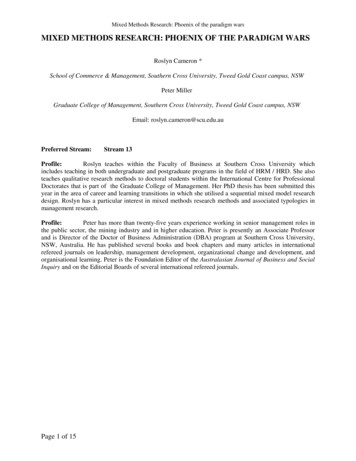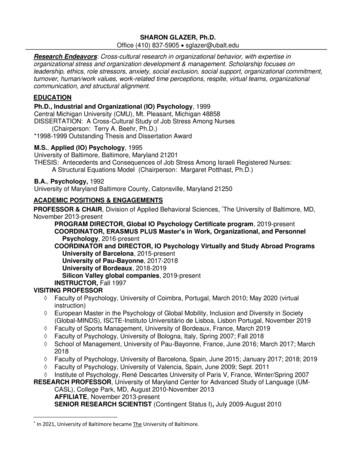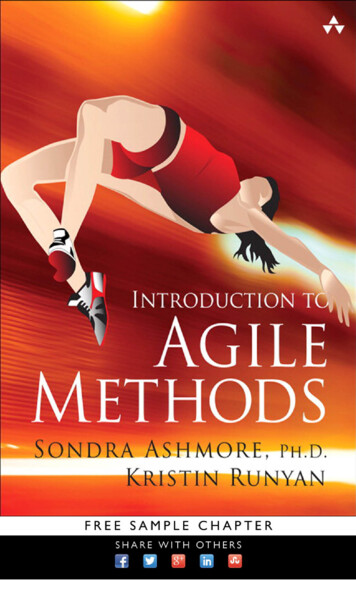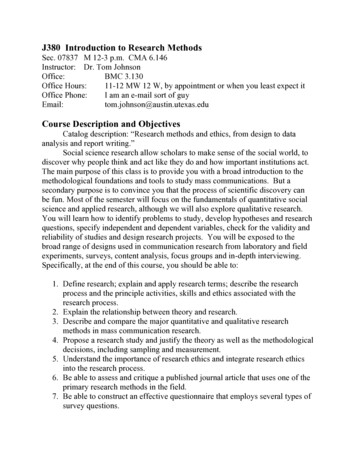
Transcription
J380 Introduction to Research MethodsSec. 07837 M 12-3 p.m. CMA 6.146Instructor: Dr. Tom JohnsonOffice:BMC 3.130Office Hours:11-12 MW 12 W, by appointment or when you least expect itOffice Phone:I am an e-mail sort of guyEmail:tom.johnson@austin.utexas.eduCourse Description and ObjectivesCatalog description: “Research methods and ethics, from design to dataanalysis and report writing.”Social science research allow scholars to make sense of the social world, todiscover why people think and act like they do and how important institutions act.The main purpose of this class is to provide you with a broad introduction to themethodological foundations and tools to study mass communications. But asecondary purpose is to convince you that the process of scientific discovery canbe fun. Most of the semester will focus on the fundamentals of quantitative socialscience and applied research, although we will also explore qualitative research.You will learn how to identify problems to study, develop hypotheses and researchquestions, specify independent and dependent variables, check for the validity andreliability of studies and design research projects. You will be exposed to thebroad range of designs used in communication research from laboratory and fieldexperiments, surveys, content analysis, focus groups and in-depth interviewing.Specifically, at the end of this course, you should be able to:1. Define research; explain and apply research terms; describe the researchprocess and the principle activities, skills and ethics associated with theresearch process.2. Explain the relationship between theory and research.3. Describe and compare the major quantitative and qualitative researchmethods in mass communication research.4. Propose a research study and justify the theory as well as the methodologicaldecisions, including sampling and measurement.5. Understand the importance of research ethics and integrate research ethicsinto the research process.6. Be able to assess and critique a published journal article that uses one of theprimary research methods in the field.7. Be able to construct an effective questionnaire that employs several types ofsurvey questions.
28. Construct an effective research proposal that will serve as the launchingpoint for the study you conduct next semester.TextbooksSchutt, R. K. (2012). Investigating the Social World: The Process and Practice ofResearch (7th edition). Los Angeles: Sage.Recommended: Poindexter, P. M., & McCombs, M. E. (2000). Research in MassCommunication: A Practical Guide. Bedford/St. Martin’s.Course Assignments and GradingExam: There will be exam just after the midterm of the semester. Theexam will be a combination of definitions, multiple choice and short answers. Finda word and connect the dots is also possible, but highly unlikely. The exam isscheduled for Oct. 28.Critiques: You will each critique and from the four kinds of research wewill discuss in class: survey research, content analysis, experiments or qualitativeanalysis. The critique should be 305 pages long. Your critiques should analyze thearticles based on our discussions of what are the criteria used to judge goodresearch in that research methodology. The critiques are due the week after wetalk about the methodology. More detail about the assignment can be found inassignment #1.In class exercises: We will have several in-class exercises to help you learnthe concepts introduced in class. You need to be in class that day to receive creditfor the exercises. The exercises are part of your participation grade.Questionnaire: Everyone will create a portion of a survey questionnairethat will focus on main independent and dependent variables. A fuller discussionis contained in assignment #2. The questionnaire is due October 7.Research Proposal: This will be a 5-7 page document where you spell outyour topic, provide a brief description of the literature review and theoreticalframework, and explain your methodology. This will be completed in three parts.The description of the topic will be due Sept. 23rd. The rough draft of the proposalis due Nov. 11 and the final draft is due Nov. 25th. During the last class period youwill provide a powerpoint presentation of your study you will write the nextsemester
3GradingExamResearch Status ReportCritiqueParticipation100 points100 points25 points25 pointsThere will also be a potential to earn up to 15 points extra credit by participating insurveys or experiments by college faculty.I have also created a Facebook group for this class: J380 Introduction to ResearchMethods: Add it Up. This will be used to send messages to the class as well as topost links.Learning Objectives and AssessmentThis is a core course required of all doctorate and theory and research master’sstudentsLearning Objectives.After this course:Students will be able to select appropriatequantitative methodologies for use in a study to beperformed in the spring. These methodologiesinclude, but are not limited to, experimental,survey and content analysis.Students will be able to describe basic approachesto qualitative research. These methodologiesinclude, but are not limited to, case studies, indepth interviews and focus groups.Students will be able to identify and critiquearticles based on different research methodsStudents will be able to construct a questionnairerelying on several types of questionsStudents will be able to write an effect researchproposal that spells out a project they will conductspring semesterAssessment Techniques.Class discussions and instructor lecturesExaminationClass discussions and instructor lecturesExaminationsClass discussions and instructor lecturesExaminationClass discussions and instructor lecturesClass discussions and instructor lectures
4Important Course Rules and Policies1. Attendance:This is a course that deals with some difficult issues, so attendance is essential forgood performance. I will allow you three absences. After the third absence, I willdeduct half a letter grade for each additional absence. You need to contact me inadvance if you are going to miss a class. All tests must be taken during theirscheduled time unless you have made prior arrangements. Assignments are due atthe beginning of class on the date indicated except for the final draft of theResearch Status Report, which is due at 4:30. I will deduct 10 percent for everyday the assignment is late. I will not accept any papers more than a week late.2. Religious Holy Days Observance Policy:The Texas Education Code specifies that an institution of higher education shallexcuse a student from attending classes or other required activities, includingexaminations, for the observance of a religious holy day, including travel for thatpurpose. A student whose absence is excused under this subsection may not bepenalized for that absence and shall be allowed to take an examination or completean assignment from which the student is excused within a reasonable time after theabsence. A student who misses classes or other required activities, includingexaminations, for the observance of a religious holy day should inform theinstructor as far in advance of the absence as possible, so arrangements can bemade to complete an assignment within a reasonable time after the talogs/gi0304/ch4/ch4g.html#attendanceStudents with Disabilities:Please notify your instructor of any modification/adaptation you may require toaccommodate a disability-related need. You will be requested to providedocumentation to the Dean of Student's Office in order that the most appropriateaccommodations can be determined. Specialized services are available on campusthrough Services for Students with ssd/Policy on Scholastic Dishonesty:The University defines academic dishonesty as cheating, plagiarism, unauthorizedcollaboration, falsifying academic records, and any act designed to avoid
5participating honestly in the learning process. Scholastic dishonesty also includes,but is not limited to, providing false or misleading information to receive apostponement or an extension on a test, quiz, or other assignment, and submissionof essentially the same written assignment for two courses without the priorpermission of the instructor. By accepting this syllabus, you have agreed to theseguidelines and must adhere to them. Scholastic dishonesty damages both thestudent's learning experience and readiness for the future demands of a workcareer. Students who violate University rules on scholastic dishonesty are subjectto disciplinary penalties, including the possibility of failure in the course and/ordismissal from the int student.php.The Honor Code:The core values of the University of Texas at Austin are learning, discovery,freedom, leadership, individual opportunity, and responsibility. Each member ofthe University is expected to uphold these values through integrity, honesty,fairness, and respect toward peers and community.Computers and Cell PhonesI will provide powerpoints before class on Blackboard for each of the lectures, soyou are encouraged to bring your laptop to take notes. Cellphones need to remainsilenced and put away during the class. I had a colleague who required people tosing “I am little teapot” if their cell phone went off. Don’t force me to enforce thatrule.Make-up ExamsNo make-up exams will be given except in the cases of family emergency,incarceration, official University of Texas business, or serious health issues. Youmust notify me no later than the day of the exam or you will not have theopportunity to make it up and show me an adequate written documentation toqualify for a make-up exam. If the exam schedules conflict with a religiousholiday, bring this to my attention by the end of the second week of class. After thesecond week of class, only those with a formal, written excuse from a doctor willhave exams rescheduled.
6LECTURE TOPICS AND READING ASSIGNMENTSCourse Outline (Subject to Change)WeeksTopicsWeek 1 (Aug. 26)Week 2 (Sept. 2)Semester hasn’t started yetSTILL don’t meetHappy Labor Day!Week 3 (Sept. 9)We FINALLY meet!Introduction to classWhat is Social Scienceand CommunicationResearch?The Scientific MethodConceptualization andmeasurementSampling and surveyResearchWeek 4 (Sept 16)Week 5 (Sept 23)Week 6 (Sept. 30)Week 7 (Oct. 7)Week 9 (Oct. 14)Week 10 (Oct. 21)Research Design &ExperimentsContent AnalysisIRB and DevelopingResearch Proposal;Research EthicsReadings/AssignmentsSchutt, chapt 1Schutt, Chapter 2Schutt, Chapter 4Due: Research Topic MemoSchutt, Chapters 5 & 8Recommended: Poindexter (P)and McCombs (M), chapt. 4 & 5Schutt, Chapter 6 & 7Due: Survey questionnaireSchutt, Chapter 13Poindexter & McCombs, chapt. 11Survey or experiment critiquedueSchutt, p. 57-58, Chapt 3“Recommended Ethical Research Guidelines for cs-researc“Faculty Council Research Policy Committee’sRecommended Standards of Ethical Research at 20092010/legislation/ethical rsch stnds.htmlContent analysis critique dueWeek 11 (Oct. 28)Q&AExamClean up
7Week 12 (Nov. 11)Week 13 (Nov. 18)Week 14 (Nov. 25)Week 15 (Dec 2)Qualitative research inmass communicationConsultation on ResearchproposalWork on your ResearchProposalsPresent your resultsSchutt, Chapter 9Due: Research Proposal DraftDue: Final proposalDue: Powerpoint Presentation
8Assignment #1 Critiques of articlesEveryone will critique an article found in a major mass communication journal.The critiques should be 3-5 pages long and are due the week after we talk aboutthe method in class. So critiques based on survey or experimental studies are dueon Oct. 14. Critiques based on content analysis are due Oct. 21. Critiques basedon an empirical qualitative method is due Nov. 18Go online and examine the most recent issues of the following journals:Communication Research, Journal of Communication, Mass Communication &Society, Journalism & Mass Communication Quarterly and Journal of ComputerMediated Communication. Find an article that interests you among the articles andthat employs one of the research techniques we will discuss in class: surveys,experiments, content analysis, in-depth interviews, focus groups, case studies orparticipant observation. It makes sense to choose an article employing themethodology you will use for your study. Copy the article so that you can turn itin with your critique. Your critique should contain the following elements:1. Provide a complete citation of the article (Title, authors, journal, volume,year and pages).2. What are the research questions/hypotheses?3. What are the major theories that it examines (be sure to briefly explain thetheory)?4. What is the research methodology (sample size, independent variables,dependent variables and how were they measured)?5. Summarize the major results6. What does the author say is the major contribution of the study?7. What would you say are the strengths and weaknesses of the study with afocus on its methodology?
9Assignment #2Writing a survey questionnaireBased on class discussion and your readings on writing good valid surveyquestions, write a 5-7 page survey questionnaire about a topic in masscommunications that interests you. If you are doing a survey for your study in thisclass it would be logical to do questions you can use in that study. As we indicatedin class, you do not need to re-invent the wheel. Indeed, it is better to use existingmeasures because you can better argue their validity. While I indicate you need atleast one question of each of the type listed below, it is better if you can findrelated ones that you could use to form into a scale. You should label eachquestion for the type of question it is and if you took if from an existing studyplease give the citation for the study. Labels should appear
Course Description and Objectives Catalog description: “Research methods and ethics, from design to data analysis and report writing.” Social science research allow scholars to make sense of the social world, to discover why people think and act like they do and how important institutions act. The main purpose of this class is to provide you with a broad introduction to the methodological .

